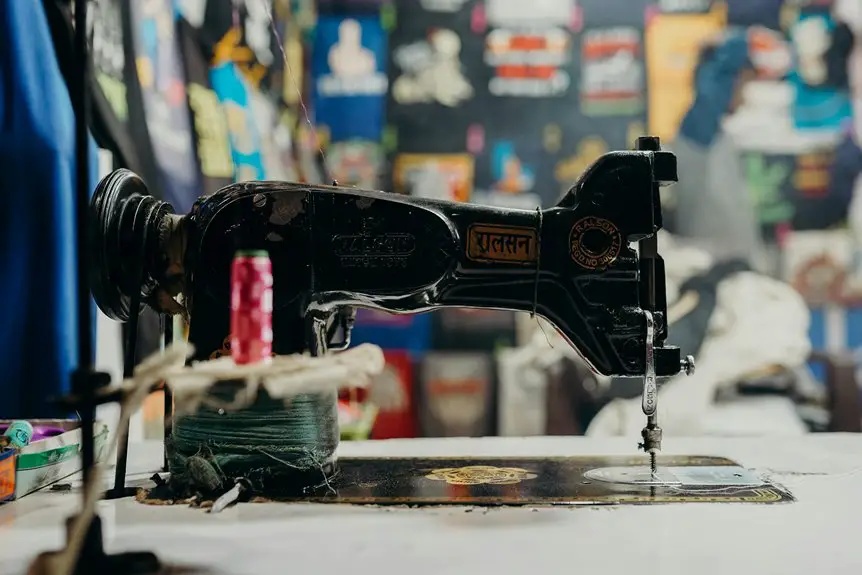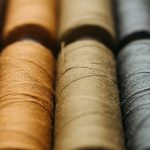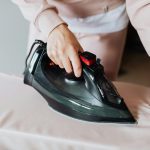You can iron polypropylene fabric, but you need to be very careful. It melts at a low temperature (around 320°F), so use the lowest heat setting and avoid steam. Always place a pressing cloth between the iron and fabric, and keep the iron moving to prevent damage like melting, warping, or shiny spots. If you want to protect your clothes and learn safer alternatives, there’s more useful advice to help you handle this fabric properly.
Table of Contents
Key Takeaways
- Polypropylene fabric has a low melting point (320°F–338°F), making it susceptible to heat damage from ironing.
- Iron only at low temperatures below 300°F (150°C) and avoid using steam to prevent fiber distortion.
- Always use a pressing cloth between the iron and fabric to protect the material from direct heat.
- Keep the iron moving continuously and press gently to avoid melting, warping, or shiny patches on the fabric.
- Consider alternatives like steaming from a distance, air drying after misting, or using a low-heat dryer to reduce wrinkles safely.
Understanding Polypropylene Fabric and Its Properties
Polypropylene fabric is a synthetic material known for its durability and resistance to moisture. When you use it, you’ll notice it’s lightweight yet strong, making it perfect for activewear, upholstery, and outdoor gear.
Its water-repellent nature means it dries quickly, so you won’t have to worry about soggy clothes or mildew. Plus, polypropylene resists chemicals and stains better than many other fabrics.
However, it’s worth noting that it has a low melting point, so it can’t handle high heat. You’ll also find it doesn’t absorb dyes easily, meaning colors mightn’t be as vibrant as with natural fibers.
Knowing these properties helps you care for polypropylene properly and understand its limitations in everyday use.
Why Ironing Polypropylene Can Be Risky
You need to be careful when ironing polypropylene because it has a low melting point that can cause it to melt or warp under high heat.
Applying too much heat risks permanently damaging the fabric’s texture and shape.
Understanding these risks helps you avoid ruining your polypropylene garments.
Melting Point Risks
Although it might seem harmless, ironing polypropylene fabric carries a significant risk because the material melts at relatively low temperatures.
Polypropylene’s melting point ranges between 320°F to 338°F (160°C to 170°C), which is lower than many common ironing settings. When you apply a hot iron directly, the fabric can quickly melt, causing it to stick to your iron or create shiny, warped spots on the garment.
You might think using a low heat setting solves the problem, but even slight overheating can lead to irreversible damage.
To protect your clothing and your iron, it’s best to avoid direct ironing altogether. Instead, consider alternative methods like steaming or placing a protective cloth between the iron and the fabric to minimize the melting risk.
Fabric Damage Concerns
When heat meets polypropylene fabric, the risk of damage increases considerably. You might think ironing is a quick fix for wrinkles, but applying direct heat can cause the fibers to warp, melt, or become misshapen.
Polypropylene’s low melting point means even moderate temperatures can lead to permanent fabric distortion. Besides melting, you could also see discoloration or shiny spots where the iron’s heat has altered the surface.
These changes weaken the fabric’s integrity, reducing its lifespan and making it prone to tears. If you’re not careful, ironing polypropylene can do more harm than good, so it’s best to avoid high heat and consider alternative wrinkle-removal methods to keep your garments looking their best without risking damage.
The Melting Point of Polypropylene and Its Significance
Understanding the melting point of polypropylene is crucial if you want to iron it safely. Polypropylene melts at around 160 to 170°C (320 to 338°F), which is relatively low compared to other fabrics. This means you need to be cautious when applying heat to avoid melting or deforming the fabric.
Keep these key points in mind:
- Set your iron to a low or synthetic setting, never exceeding polypropylene’s melting point.
- Use a pressing cloth to create a barrier between the iron and fabric.
- Avoid prolonged contact with the iron to prevent heat buildup.
- Test a small, hidden area first to verify the temperature won’t damage the fabric.
Knowing this helps you prevent accidents and maintain your polypropylene items in great condition.
Signs That Your Polypropylene Fabric Has Been Damaged by Heat
If you’ve accidentally applied too much heat to your polypropylene fabric, you might notice a melted or warped texture that feels different to the touch.
Discoloration or unexpected stains can also be a clear sign of heat damage.
Pay close attention to any weakening of the fabric or small holes that weren’t there before.
Melted or Warped Texture
Although polypropylene fabric is durable, applying too much heat can quickly cause it to melt or warp. When this happens, you’ll notice changes in the texture that indicate damage. Instead of a smooth, even surface, the fabric might feel uneven or sticky.
Here are some signs to watch for:
- Fabric surface appears shiny or glossy in patches
- Areas feel hardened or fused together
- The material loses its original flexibility and becomes stiff
- Visible ripples or wrinkles that won’t flatten out
If you spot any of these, it’s a clear indication that the heat was too high or applied for too long.
Avoid ironing polypropylene directly to prevent these unwanted changes.
Discoloration and Stains
Along with changes in texture, heat damage to polypropylene fabric often shows up as discoloration and stains.
If you notice yellowing, dark spots, or uneven color patches, these are clear signs the fabric has been exposed to excessive heat. This happens because high temperatures can break down the fibers and alter the dye, leading to permanent marks.
You might also see scorch marks that look like faint shadows or burns. Once these discolorations appear, they won’t fade with washing, and they can ruin the fabric’s appearance.
To avoid this, never iron polypropylene at high heat or use steam. Instead, opt for low heat settings or alternative wrinkle-removal methods to keep your fabric looking fresh and stain-free.
Fabric Weakness and Holes
When you expose polypropylene fabric to excessive heat, you’ll often notice it becomes weaker and more prone to holes. The heat damages the fibers, causing them to lose strength and integrity.
Over time, this can lead to small tears or holes that compromise the fabric’s durability. Watch out for these signs that your polypropylene has been damaged by heat:
- Fabric feels thinner or more fragile than usual
- Small holes or tears appearing unexpectedly
- Areas that stretch or snag easily
- Uneven texture or rough patches where fibers have melted
If you spot any of these, it’s a clear sign the fabric’s been compromised. To avoid this, always use low heat or avoid ironing polypropylene altogether.
Safe Ironing Temperatures for Polypropylene
Because polypropylene fabric is sensitive to high heat, you need to use low temperatures when ironing to avoid melting or damaging it. The safest setting is usually the lowest heat on your iron, often labeled as “synthetics” or around 110°C (230°F).
Avoid using steam, as moisture combined with heat can weaken the fibers. Also, never place the iron directly on the fabric; always use a pressing cloth to provide a protective barrier.
If your iron has temperature control, start with the lowest setting and gradually increase only if absolutely necessary, watching closely for any signs of damage.
Sticking to these low temperatures guarantees your polypropylene fabric stays intact without warping, shrinking, or developing holes from excessive heat exposure.
Recommended Iron Settings and Techniques for Polypropylene
To iron polypropylene safely, set your iron to a low temperature, typically below 300°F (150°C).
Avoid using steam directly, as moisture and heat together can damage the fabric.
Always use a pressing cloth to protect the material and prevent melting or shiny spots.
Ideal Temperature Range
A low heat setting is essential when ironing polypropylene fabric to prevent melting or warping. You should keep your iron temperature between 230°F (110°C) and 300°F (149°C) for the best results. Avoid high heat since polypropylene has a low melting point around 320°F (160°C).
Here are some tips to maintain the ideal temperature range:
- Use the synthetic or low heat setting on your iron.
- Test on a small, hidden area before ironing the entire garment.
- Keep the iron moving continuously to avoid heat buildup.
- Place a pressing cloth between the iron and fabric for extra protection.
Steam Usage Guidelines
How should you handle steam when ironing polypropylene fabric? You should avoid using steam because polypropylene is sensitive to moisture and heat. Steam can cause the fibers to warp or melt, leading to permanent damage.
Instead, set your iron to the lowest dry heat setting, often labeled as “synthetic” or “plastic.” Before ironing, make sure the fabric is completely dry. If you feel the fabric needs smoothing, lightly press without steam, moving the iron quickly to prevent overheating any spot.
Avoid leaving the iron in one place too long. If you want to reduce wrinkles, consider using a pressing cloth between the iron and the fabric to protect it further. Following these steam usage guidelines will help keep your polypropylene garments looking their best without damage.
Protective Pressing Methods
When ironing polypropylene fabric, choosing the right settings and techniques is essential to prevent damage.
Since polypropylene melts at low temperatures, you need to be cautious and protective during pressing.
Here are some recommended methods:
- Use the lowest heat setting on your iron, typically “synthetic” or “polyester.”
- Always place a pressing cloth or a thin cotton towel between the iron and the fabric.
- Avoid applying heavy pressure; instead, press gently to smooth wrinkles.
- Limit ironing time on any single spot to prevent overheating and melting.
Alternatives to Ironing Polypropylene Fabric
You’ll find several effective alternatives to ironing polypropylene fabric that preserve its integrity while removing wrinkles. Instead of using an iron, try steaming your fabric with a handheld steamer or by hanging it in a hot, steamy bathroom. The gentle moisture and heat relax the fibers without risking damage.
You can also smooth out wrinkles by laying the fabric flat and using your hands to press and reshape it. Another option is to hang the fabric immediately after washing to let gravity help reduce creases naturally.
If you prefer, toss the fabric in the dryer on a low or no-heat setting with a damp cloth for a short time, which can help ease out wrinkles safely. These methods keep your polypropylene looking fresh without the risk of melting or burning.
How to Remove Wrinkles From Polypropylene Without an Iron
Wondering how to smooth out wrinkles from polypropylene fabric without risking damage from an iron? You can easily freshen up your polypropylene items using gentle methods that keep the fabric safe.
Try these effective techniques:
- Use a steamer: Hold a handheld steamer a few inches away and let the steam relax the fibers.
- Hang in a humid bathroom: After a hot shower, hang your garment in the steamy environment to reduce wrinkles naturally.
- Dampen and air dry: Lightly mist the fabric with water, then smooth it out and let it air dry flat or on a hanger.
- Use a hairdryer: Spray some water on the wrinkled area and blow-dry on a low heat setting, keeping the dryer moving.
These tips will keep your polypropylene fabric wrinkle-free without an iron’s heat risk.
Caring for Polypropylene Clothing to Minimize Wrinkles
Although polypropylene fabric resists wrinkles better than many materials, proper care can further reduce creasing and keep your clothes looking sharp.
Polypropylene fabric naturally resists wrinkles, but proper care keeps your clothes looking crisp and sharp.
When washing, use cold water and a gentle cycle to prevent fabric stress. Avoid overloading the washing machine, as crowded garments crease more easily.
After washing, promptly remove your polypropylene items and shake them out to smooth wrinkles before drying. Hang or lay them flat to dry, steering clear of high heat that can damage fibers.
When storing, fold clothes carefully or hang them to maintain their shape and avoid deep creases.
When to Avoid Ironing Polypropylene Garments Entirely
Since polypropylene fabric is sensitive to heat, you should avoid ironing it when the garment label explicitly warns against it or if the fabric shows any signs of melting or warping. Ignoring these warnings can permanently damage your clothing.
Also, steer clear of ironing if:
- The fabric has strong synthetic blends that react unpredictably to heat
- The garment features embellishments like prints, adhesive patches, or reflective strips
- You notice stubborn wrinkles that don’t respond to low heat settings
- The fabric has been treated with special coatings or finishes that might degrade under heat
In these cases, it’s safer to try alternative wrinkle removal methods like steaming or hanging your garment in a humid bathroom.
Protect your polypropylene clothing by respecting these limits and preserving its lifespan.
Frequently Asked Questions
Can Polypropylene Fabric Be Safely Dry Cleaned?
You shouldn’t dry clean polypropylene fabric because it can be damaged by harsh chemicals. Instead, you’ll want to spot clean or hand wash it gently with mild detergent to keep it safe and in good condition.
Is Polypropylene Fabric Hypoallergenic?
You’ll find polypropylene fabric is generally hypoallergenic because it resists moisture and bacteria buildup. So, if you have sensitive skin or allergies, wearing polypropylene can help reduce irritation and keep you comfortable throughout the day.
How Does Polypropylene Fabric Compare to Polyester in Durability?
Wondering which lasts longer, polypropylene or polyester? You’ll find polypropylene is more resistant to abrasion and chemicals, making it durable for active use, while polyester offers better UV resistance and overall strength. Choose based on your needs!
Can Polypropylene Fabric Be Recycled?
You can recycle polypropylene fabric since it’s a type of plastic labeled #5. Just check local recycling programs because not all accept it. Recycling helps reduce waste and supports sustainability efforts in your community.
What Are Common Uses of Polypropylene Fabric in Everyday Products?
Imagine your favorite backpack or reusable grocery bag—chances are, they’re made from polypropylene fabric. You’ll find it in activewear, upholstery, and even medical supplies, thanks to its durability, moisture resistance, and lightweight feel.
- The Use of Nonwovens in Construction and Civil Engineering - July 11, 2025
- The Use of Nonwovens in Construction and Civil Engineering - July 11, 2025
- The Use of Nonwovens in Construction and Civil Engineering - July 11, 2025







